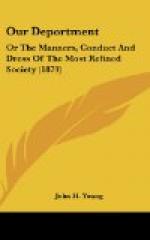CALLING CARDS.
A card used in calling should have nothing upon it but the name of the caller. A lady’s card should not bear her place of residence; such cards having, of late, been appropriated by the members of the demi-monde. The street and number always look better upon the card of the husband than upon that of the wife. When necessary, they can be added in pencil on the cards of the wife and daughter. A business card should never be used for a friendly call. A physician may put the prefix “Dr.,” or the affix “M.D.,” upon his card, and an army or navy officer his rank and branch of service.
WEDDING CARDS.
Wedding cards are only sent to those people whom the newly married couple desire to keep among their acquaintances, and it is then the duty of those receiving the cards to call first on the young couple.
An ancient custom, but one which has been recently revived, is for the friends of the bride and groom to send cards; these are of great variety in size and design, and resemble Christmas or Easter cards but are usually more artistic.
CHRISTMAS AND EASTER CARDS.
A very charming custom that is coming into vogue is the giving or sending of Easter and Christmas cards. These are of such elegant designs and variety of colors that the stationer takes great pride in decorating his shop windows with them; indeed some of them are so elegant as to resemble oil paintings. Books and other small offerings may accompany cards as a token of remembrance.
CARDS TO SERVE FOR CALLS.
A person may make a card serve the purpose of a call, and it may either be sent in an envelope, by messenger or left in person. If left in person, one corner should be turned down. To indicate that a call is made on all or several members of the family; the card for the lady of the house is folded in the middle. If guests are visiting at the house, a card is left for each guest.
ENCLOSING A CARD IN AN ENVELOPE.
To return a call made in person with a card inclosed in an envelope, is an intimation that visiting between the parties is ended. Those who leave or send their cards with no such intention, should not inclose them in an envelope. An exception to this rule is where they are sent in return to the newly married living in other cities, or in answering wedding cards forwarded when absent from home. P.P.C. cards are also sent in this way, and are the only cards that it is as yet universally considered admissible to send by post.
SIZE AND STYLE OF VISITING OR CALLING CARDS.
A medium sized is in better taste than a very large card for married persons. Cards bearing the name of the husband alone are smaller. The cards of unmarried men should also be small. The engraving in simple writing is preferred, and without flourishes. Nothing in cards can be more commonplace than large printed letters, be the type what it may. Young men should dispense with the “Mr.” before their names.




